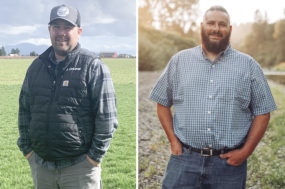As many veterinarians, nutritionists, farmers and students would agree, management during the transition period is one of the most crucial roles to produce a successful lactation. Making your transition cow program a success relies heavily upon proper body condition score at calving, minimizing pre-calving energy intake and maximizing feed intake throughout the freshening period. Although special attention is commonly given to transition cows, heifers calving for the first time are often not seen as high-risk animals. This may be due to the fact that heifers often suffer from lower rates of milk fever, or displaced abomasum during the fresh period, when compared to animals in their second or third lactation.
However, the unique needs of first-calf heifers should be taken into consideration during the transition period, as these animals are beginning to provide a return on your investment of replacement animals.
Researchers have noted through on-farm studies that heifers have a significantly higher incidence of mastitis during the fresh period compared to their older herd mates. Much of this increase in mastitis when the animal freshens can be contributed to the heiferâs inability to cope with stress before calving.
Minimizing the stress of moving to a new facility, being grouped with older animals and changing diets should all be taken into consideration when managing transition heifers in order to maximize the lifetime production of these replacement animals.
Heifers and mature cows have many similarities when it comes to dietary needs, both suffering from a period of negative energy balance early in lactation. Although heifers produce less milk and colostrum compared to mature cows, they require additional energy for growth.
Researchers in Wisconsin have demonstrated that maintaining dry cows on a moderate-energy pre-calving diet results in a reduced incidence of ketosis and other metabolic diseases post-calving.
Although only a handful of studies have examined heifers during the transition period, the same appears to be true: heifers benefit from a moderate-energy diet pre-calving as opposed to being âsteamed upâ with high-energy, high-grain diets. Limiting energy of the diet through the addition of forages in the ration has been shown to be a successful method of moderating energy intake of dry cows and first-calf heifers.
With an age at first calving of 24 months old, heifers should be at approximately 80 to 85 percent of their mature bodyweight. To allow your heifers to grow out properly, together with your nutritionist, you must work to meet the higher demands for protein of the growing heifer. This not only allows the heifer to continue to grow, but has shown to be beneficial for production in her first lactation.
One study in particular demonstrated that when heifers were fed a higher-protein diet (14.7 percent vs 12.7 percent) before calving, they were able to produce, on average, an extra 4.4 lbs (2 kilograms) of milk per day for the first 120 days of lactation.
A more recent study has also noted that somatic cell count was elevated in heifers with low milk urea nitrogen at first DHIA test day, indicating that limiting protein to first-calf heifers may have detrimental effects beyond milk production.
One issue that stands out with transition heifers is the increase in udder edema experienced pre-calving compared to mature cows. Although there is no clear cause of udder edema, researchers agree that the swelling of the udder is caused from a number of compounding factors.
High-grain diets, overconditioned animals, as well as increased metabolic stressors on the udder, have been shown to cause this increase in swelling.
Researchers have also noted that excessive sodium and potassium intake have been associated with an increase in edema, and limiting salt intake pre-calving may be a method of preventing this issue. Lowering the dietary cation-anion difference (DCAD) by selecting low-potassium forages may also have beneficial effects in reducing udder edema.
Anionic salts or acid-treated feeds should not be fed to heifers. Research has shown that, due to the continued growth and development of muscle and bone in heifers, they are able to maintain adequate calcium levels for lactation.
The addition of anionic salts in the diet tends to decrease feed intake of first-calf heifers, resulting in depressed growth rate when compared to heifers that are unsupplemented.
Managing the protein and DCAD of dry cow rations can be difficult when housing close-up dry cows and heifers in the same group, even though both age groups benefit from a moderate-energy dense diet pre-calving.
Choice of feeds offered to the close-up group must be taken into consideration to limit the amount of anionic supplements needed to lower the DCAD of the diet to a level that prevents milk fever in mature cows but does not push heifers off feed. Through discussions with their nutritionists and veterinarians, many producers have been able to have a successful transition program for both heifers and mature cows.
In general, heifers will benefit from being housed separately from mature animals, as heifers consume less feed than mature cows, and make multiple short visits to the feedbunk compared to the longer meals of mature cows. Separating these groups decreases the social competition at the feedbunk, allowing for adequate feed intake of timid heifers.
However, in many herds, separating transition heifers and cows is not practical. Common practice in these herds is to move heifers to the far-off dry cow group 60 days before calving, which allows the heifers to settle into the facility and adapt to changes in social status when housed with mature cows.
When housing heifers and mature dry cows together, it is recommended that the pen be stocked at a rate no more than 90 percent, based on feedbunk space.
Feeding for a 2 to 3 percent refusal rate has also been shown to increase feed intake in transition cows, along with limiting time spent away from feed by housing fresh cows close to the parlor (parlour). Regardless of the grouping strategy used for transition cows, body condition of heifers and mature cows should be closely monitored to maintain optimum health throughout this lactation phase.
Maintaining proper growth during the transition period is imperative to a successful heifer transition program. Avoiding overconditioned or underconditioned heifers by limiting energy intake, while meeting the protein requirements through the use of high forage diets have been shown to be important components of a successful transition program. PD

Matt Walpole
Ph.D. Student, Ruminant Nutrition and Physiology
University of Saskatchewan






